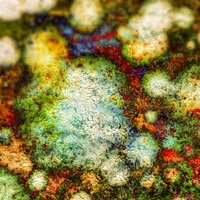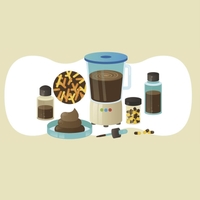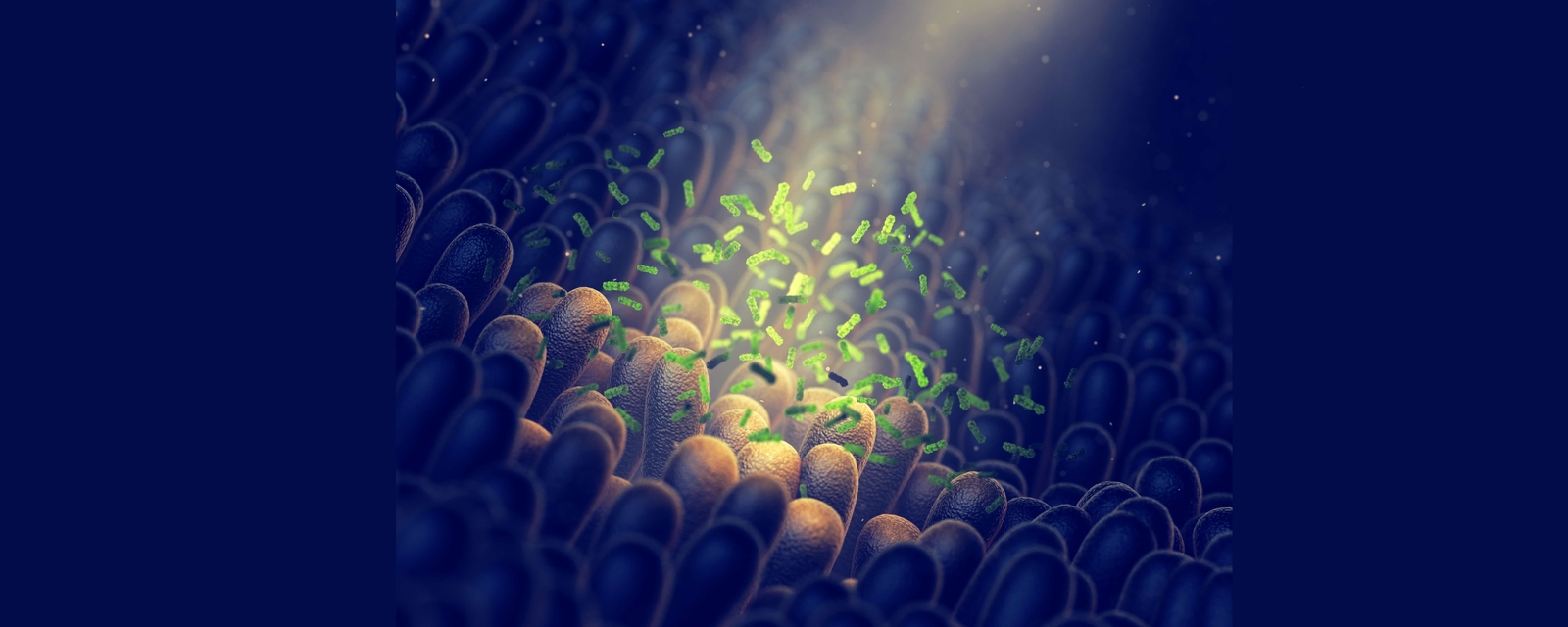
The introduction of probiotics, prebiotics, or synbiotics into the human diet is favourable for the intestinal microbiota. Probiotics are beneficial bacteria, while prebiotics are food for these bacteria. Each of these components is discussed below.
Prebiotics
Prebiotics are non-digestible selectively fermented dietary fibres that specifically promote the growth and/or activity of one or more microorganisms in the gastrointestinal tract, providing health benefits to the host (1,2). The latest definition of prebiotics expands the concept to possibly include non-carbohydrate substances, applications to body sites other than the gastrointestinal tract, and diverse categories other than food (3).
In order to be considered a prebiotic, the product/food needs to meet five criteria (Figure 1).
Figure 1. Requirements for potential prebiotics (3,4)

The inulin-type fructans and galactooligosaccharides are the two most investigated and used dietary carbohydrate prebiotics. They are effective in stimulating the growth of many different gut bacteria. In humans, prebiotic supplementation leads to increased growth of specific gut microbiota (mostly Bifidobacteria), immune modulation, and depending on the bacterial augmentation, short-chain fatty acid (SCFA) production (1,2,4).
Prebiotics occur naturally in foods such as fruit, vegetables and cereals (for more detail, see below), or are manufactured (e.g. lactulose, galactooligosaccharides (GOS), fructooligosaccharides (FOS), maltooligosaccharides, cyclodextrins, and lactosucrose) (4).
“Prebiotic” and “dietary fibre” are terms used alternatively for food components that are not digested in the gastrointestinal tract. A significant difference between these two terms is that prebiotics is fermented by strictly defined groups of microorganisms, and dietary fibre is used by the majority of colonic microorganisms (5). Prebiotics may be a dietary fibre, but dietary fibre is not always a prebiotic (4). Examples of the different non-digestible carbohydrates is shown in Table 1.
Table 1. Examples of non-digestible carbohydrates (6)
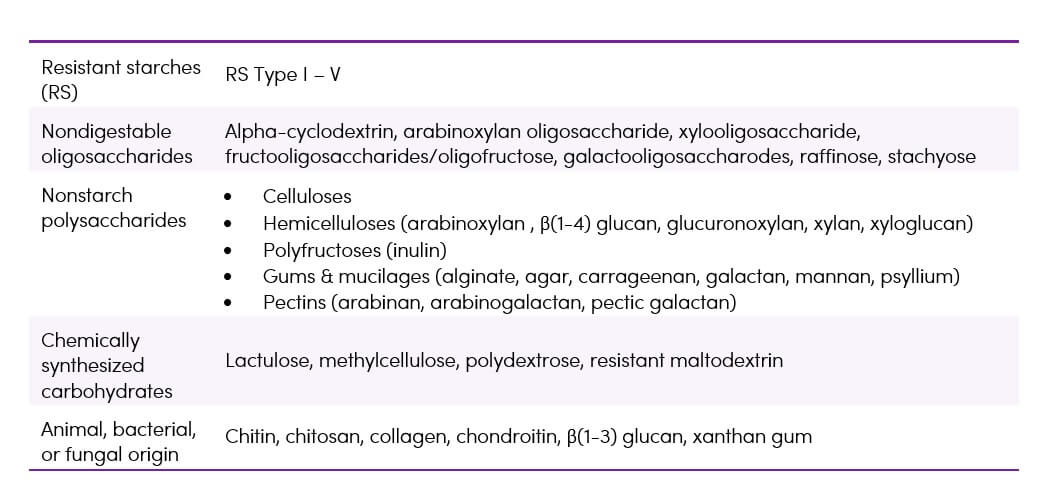
Prebiotics may be consumed on a long-term basis and for prophylactic purposes. There is no daily requirement for prebiotics. For increasing Bifidobacteria, a daily dose of 5g FOS, or 5.5g GOS are often taken. For therapeutic purposes, the typical dose of all prebiotics is 5.5–20g daily, divided into three doses and taken with meals. The optimal dose of prebiotics, without significant side-effects such as bloating, is 15g per day. An overdose of some low-digestible prebiotics is associated with impaired GIT tolerance and may lead to flatulence and diarrhoea. Other prebiotic fibres (e.g. wheat dextrin) show no laxative effect up to 45 g/day (1,4,7).
Irritable bowel syndrome (IBS) and Crohn’s disease (CD) are gastrointestinal disorders associated with reductions in some gut bacteria and greater mucosal inflammation. It is interesting that inflammatory bowel disease develops in parts of the world with a relatively low daily intake of prebiotics (8). Prebiotics show some promise at low doses for modulation of the gut bacteria and reduction of symptoms in IBS, however, larger doses may have a neutral or negative impact on symptoms.
Human trials on the effects of prebiotic supplementation on bacterial modulation and inflammatory response in CD have yielded contradictory results. Limitations in study methodologies might account for inconsistent study results. Dietary restriction of fermentable carbohydrates (low FODMAP diet), which restricts some naturally occurring prebiotics from the diet, has shown efficacy in improving symptoms in IBS, but it lowers the numbers of some key gut microbiota. Further research is required on the effect of prebiotics in gastrointestinal disorders and, in particular, on their use in conjunction with the low FODMAP diet (2).
Prebiotics may be used as additional support for probiotics (i.e. a synbiotic). Different prebiotics will stimulate the growth of different indigenous gut bacteria (e.g. Bifidobacterium infantis has specific enzymes that can hydrolyse FOS). The individual microbiota modifications of prebiotics are not easily predicted. The gut environment, especially pH, also plays a key role in determining the outcome of interspecies competition. The development of prebiotics intended to benefit human health has to take into account the highly individual species profiles that may result (4,9,10).
Benefits of prebiotics
There are many reports on the beneficial effects of prebiotics on human health including, but not limited to (1,4,8,11,12):
- Improvement of gut balance and transit
- Enhancement in gut mucosal barrier integrity and function
- Inhibition of adherence of pathogenic bacteria to the gut epithelium thereby inhibiting their colonisation
- Protection against colorectal cancer, especially with inulin and oligofructose
- Reduction of the blood low-density lipoprotein (LDL) level
- Influence the production of pro and anti-inflammatory cytokines
- Stimulation of the immunological system
- Increased absorbability of calcium and magnesium
- Maintenance of correct intestinal pH value
- Alleviation of symptoms of peptic ulcers and vaginal mycosis
- Prevention of carcinogenesis
- Support of lactose intolerance
- Improvement in complications associated with high-fat diet-induced metabolic disorders including obesity and insulin resistance
Human trials of orally administered prebiotics are summarised in Table 2.
Table 2. Health endpoints targeted in human trials of orally administered prebiotics. Adapted from (3) under CC BY 4.0

Probiotics
Probiotics are live strains of strictly selected microorganisms which, when administered in adequate amounts, confer a health benefit on the host (13). They can be taken as supplements (capsules, tablets, powders (in sachets) or liquids in measured doses) or consumed naturally through fermented foods such as yoghurt, kefir, sauerkraut, kimchi and kombucha.
Probiotic products may contain one or more selected microbial strains. Human probiotic microorganisms consist predominantly of Lactobacillus, Bifidobacterium, Lactococcus, Streptococcus and Enterococcus. Strains of Bacillus gram-positive bacteria and some yeast strains belonging to the genus Saccharomyces are also commonly used in probiotic products (4).
Delivering a single strain compared to a combination of bacteria in probiotic formulations is an important consideration, as each strain may have a different impact on microbial structure/function or on the host immune response (4,11). Circumstantial evidence supports the use of multistrain probiotics, particularly those with a high number of different strains. It’s possible that more strains convey more chances of success, a broader spectrum of efficacy and multistrain probiotics may provide additive or synergistic effects (14,15). Further research is required to confirm these effects.
Table 3. Factors to consider when selecting probiotics (4,16)
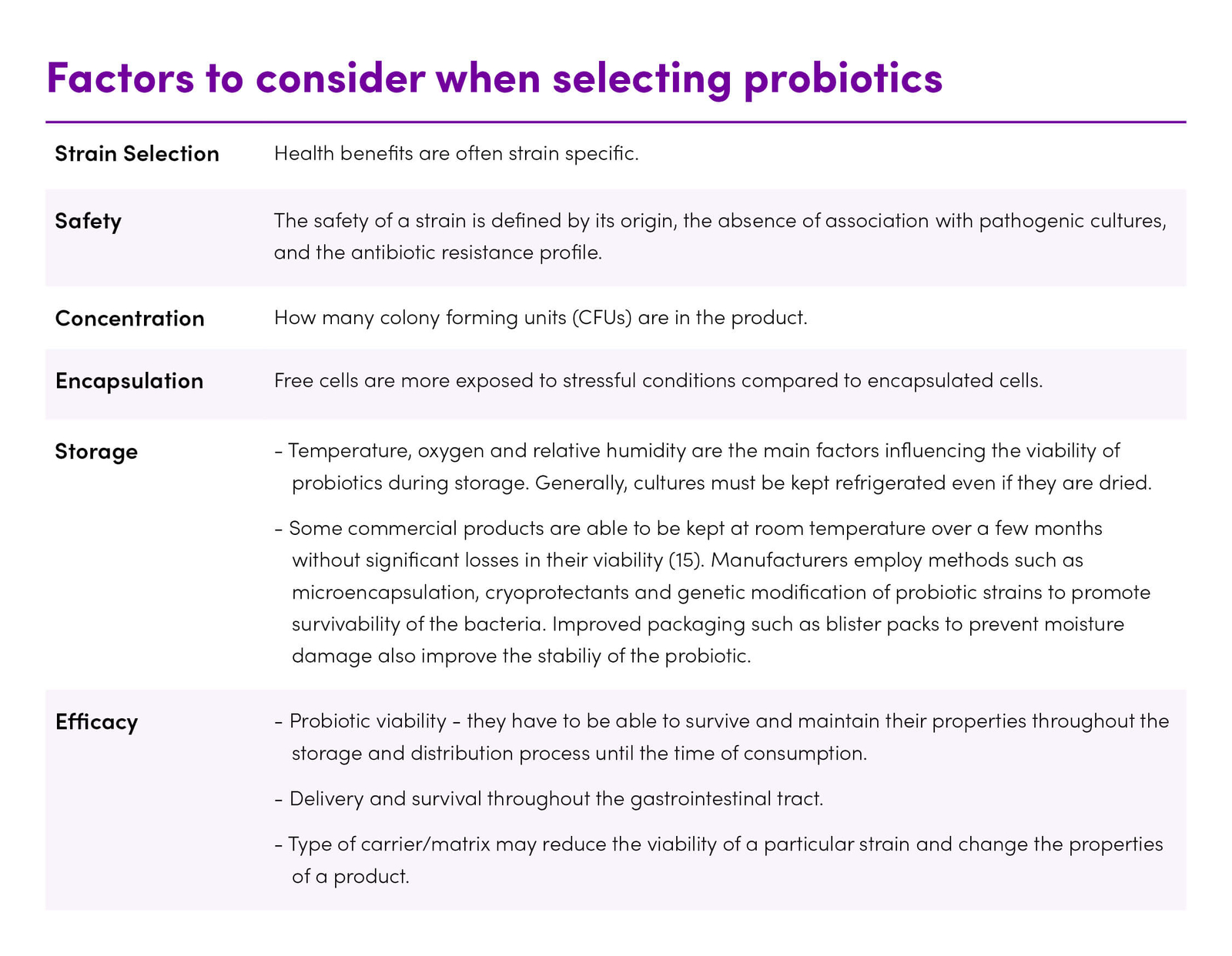
Benefits of probiotics
Probiotics are used to manipulate intestinal microbiome interactions. The health benefits of probiotic supplements and foods have been well documented, including, but not limited to the prevention and treatment of respiratory tract infections, infectious diarrhoea, atopic eczema associated with cow’s milk allergy, infant colic, necrotizing enterocolitis, bacterial vaginosis, Clostridioides difficile-associated diarrhoea, and urinary tract infections (18).
Commercial probiotic food products contain a variety of different probiotic species and strains. Certain health benefits are common to most or all probiotic species. These are considered to be “core benefits” and include the regulation of intestinal transit, normalisation of disrupted microbiota, turnover of enterocytes, competitive exclusion of pathogens, colonisation resistance and SCFA production (4,18).
Some probiotic effects are found only among specific species of probiotics. These effects include (4,18):
- Vitamin synthesis and absorption
- Generation of organic acids and amino acids
- Gut-barrier reinforcement
- Bile salt metabolism
- Enzymatic activity
- Neutralisation of carcinogens
- Neurological effects
- Immunological effects
- Endocrinological effects
- Regulation of metabolic processes (including cholesterol absorption, blood pressure and glucose metabolism)
- Respiratory tract infections
- Treatment of diarrhoea, including antibiotic-associated diarrhoea
- Treatment of inflammatory enteral conditions, including ulcerative colitis, Crohn’s disease
Beneficial effects of probiotics occur via four main mechanisms (4):
- Antagonism through the production of antimicrobial substances
- Competition with pathogens for adhesion to the epithelium and for nutrients
- Immunomodulation of the host
- Inhibition of bacterial toxin production
Synbiotics
Synbiotics have both probiotic and prebiotic properties and were created in order to overcome some possible difficulties in the survival of probiotics in the gastrointestinal tract.
The health effect of synbiotics is probably associated with the individual combination of a probiotic and prebiotic (12,19). A combination of Bifidobacterium or Lactobacillus bacteria with fructooligosaccharides in synbiotic products seems to be the most popular (4).
Benefits of synbiotics
Beneficial effects of synbiotics on human health include (4,20):
- Antibacterial, anticarcinogenic, and anti-allergic effects
- Counteract decay processes in the intestine and prevent constipation and diarrhoea
- Prevention of osteoporosis
- Reduction of blood fat and sugar levels
- Regulation of the immunological system
- Treatment of brain disorders associated with abnormal hepatic function
Figure 2. Mechanisms of action of synbiotics and their effects (4). Reprinted under CC BY 4.0
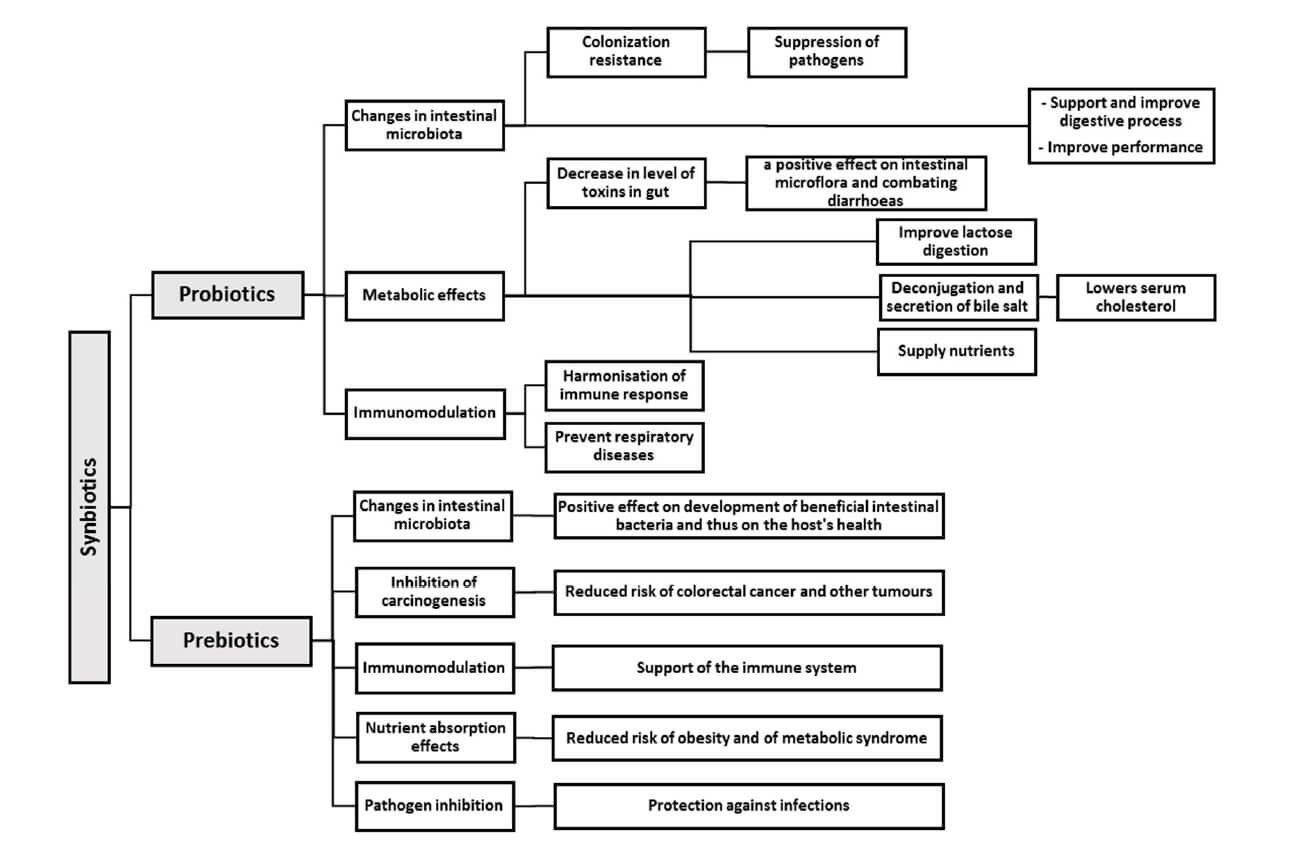
Food Containing
Prebiotics, probiotics and synbiotics can be consumed in the form of raw vegetables and fruit, fermented pickles, or dairy products. Another source may be pharmaceutical formulas and functional foods (4).
Probiotics are commonly consumed as fermented foods. The consumption of fermented foods by humankind has a long history and there are as many types of fermented food as civilizations. Examples of common fermented foods are sauerkraut, kefir, kombucha tea, kimchi, pickles, vinegar and a broad range of traditional alcoholic beverages. Yoghurts are popular foods with probiotic bacteria, and fermented milks are still very important for the delivery of probiotics (21).
Other foods have now emerged that transfer probiotic bacteria. These include chocolate, cheese, sausage and cereal products. Probiotic food products could have health benefits not currently reported on their labels, however, many dosages are too low to provide the benefits demonstrated in clinical trials (18).
Prebiotics are found in many food sources as outlined in Table 4.
Table 4. Dietary sources of prebiotics
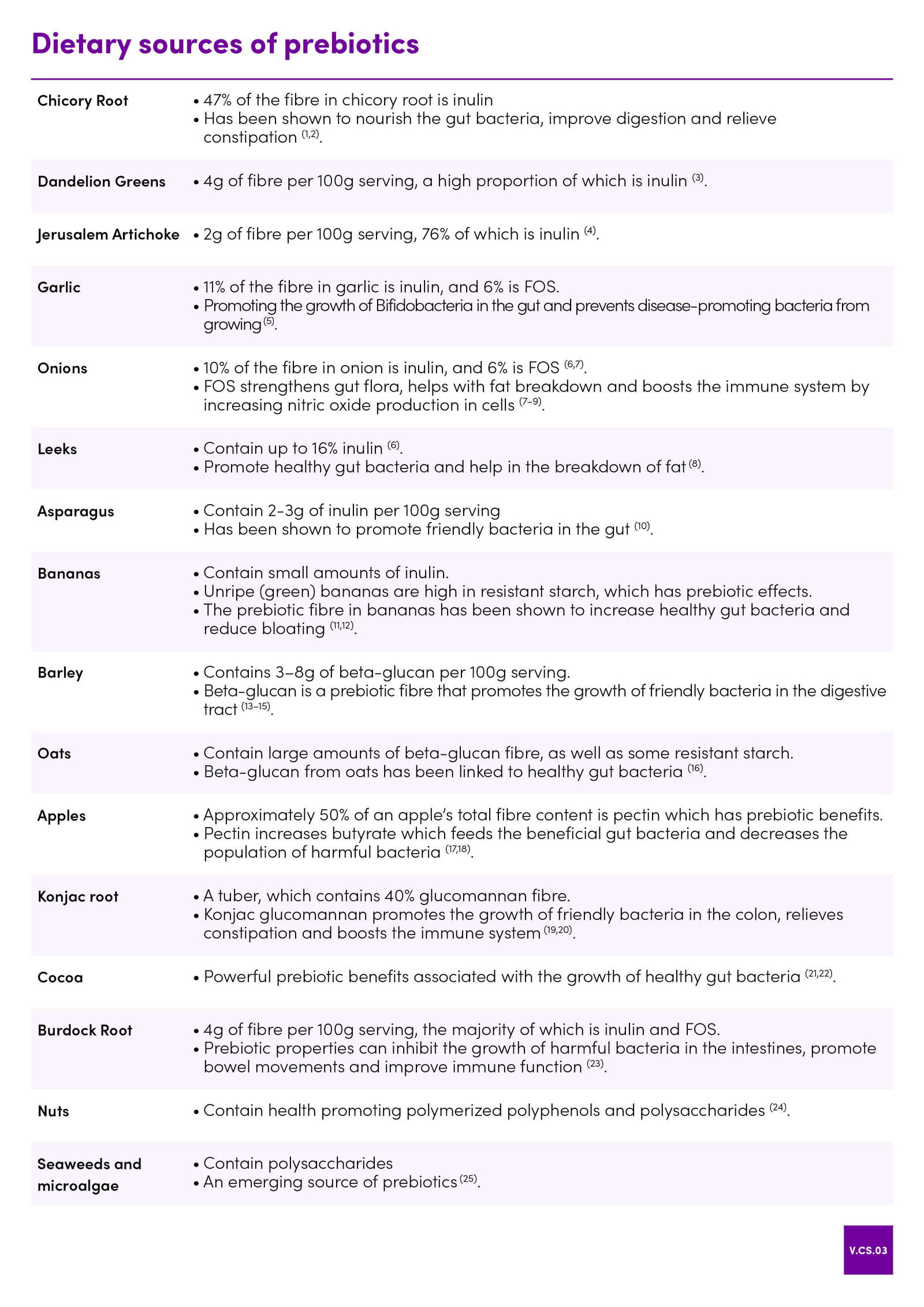
Takeaway on Prebiotic vs Probiotic
- The vast body of evidence which is accumulating at a rapid pace is showing very exciting trends in the field of the human gut microbiome and its potential for disease prevention and treatment
- Relatively cheap and easy to implement options through diet and probiotic/prebiotic supplements makes this a very promising area of clinical practice which can have an enormous impact on the lives of our clients
- Probiotic organisms are crucial for the maintenance and balance of human intestinal microbiota
- Probiotic treatment is strain specific, however multi-strain probiotics may also confer benefits
- Prebiotics may be used as additional support for probiotics. Appropriate microbial strains in combination with synergistic prebiotics may be even more effective than administering their components separately

